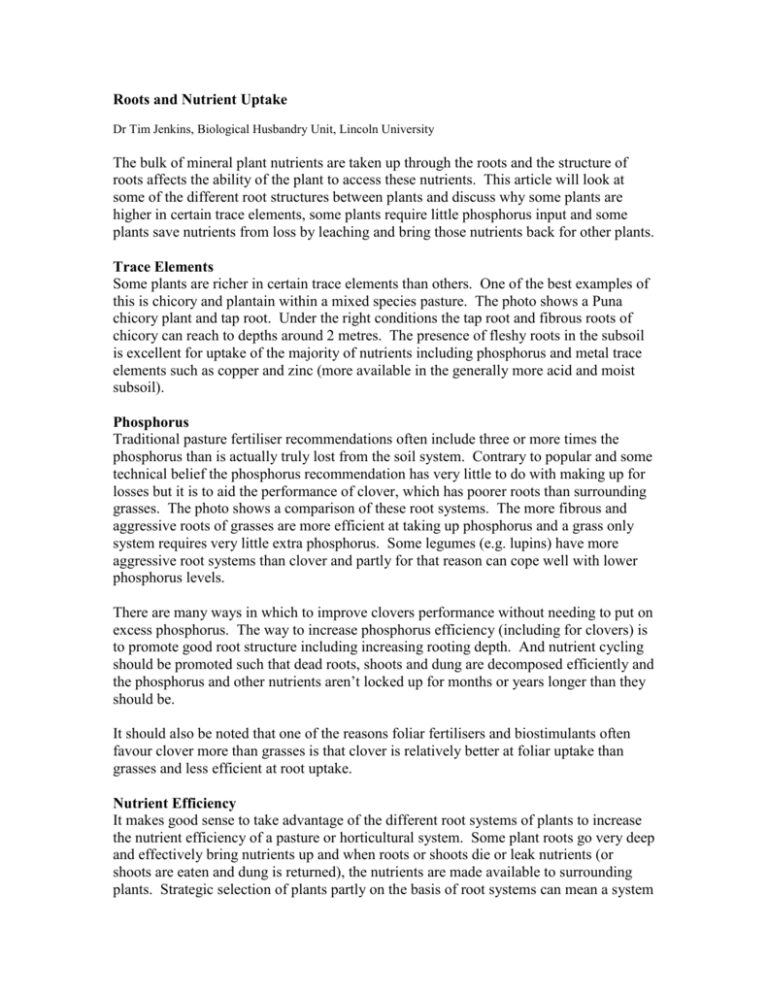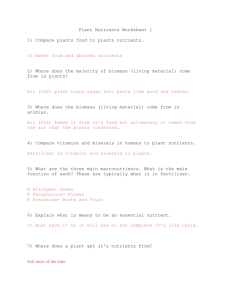Roots and Nutrient Uptake
advertisement

Roots and Nutrient Uptake Dr Tim Jenkins, Biological Husbandry Unit, Lincoln University The bulk of mineral plant nutrients are taken up through the roots and the structure of roots affects the ability of the plant to access these nutrients. This article will look at some of the different root structures between plants and discuss why some plants are higher in certain trace elements, some plants require little phosphorus input and some plants save nutrients from loss by leaching and bring those nutrients back for other plants. Trace Elements Some plants are richer in certain trace elements than others. One of the best examples of this is chicory and plantain within a mixed species pasture. The photo shows a Puna chicory plant and tap root. Under the right conditions the tap root and fibrous roots of chicory can reach to depths around 2 metres. The presence of fleshy roots in the subsoil is excellent for uptake of the majority of nutrients including phosphorus and metal trace elements such as copper and zinc (more available in the generally more acid and moist subsoil). Phosphorus Traditional pasture fertiliser recommendations often include three or more times the phosphorus than is actually truly lost from the soil system. Contrary to popular and some technical belief the phosphorus recommendation has very little to do with making up for losses but it is to aid the performance of clover, which has poorer roots than surrounding grasses. The photo shows a comparison of these root systems. The more fibrous and aggressive roots of grasses are more efficient at taking up phosphorus and a grass only system requires very little extra phosphorus. Some legumes (e.g. lupins) have more aggressive root systems than clover and partly for that reason can cope well with lower phosphorus levels. There are many ways in which to improve clovers performance without needing to put on excess phosphorus. The way to increase phosphorus efficiency (including for clovers) is to promote good root structure including increasing rooting depth. And nutrient cycling should be promoted such that dead roots, shoots and dung are decomposed efficiently and the phosphorus and other nutrients aren’t locked up for months or years longer than they should be. It should also be noted that one of the reasons foliar fertilisers and biostimulants often favour clover more than grasses is that clover is relatively better at foliar uptake than grasses and less efficient at root uptake. Nutrient Efficiency It makes good sense to take advantage of the different root systems of plants to increase the nutrient efficiency of a pasture or horticultural system. Some plant roots go very deep and effectively bring nutrients up and when roots or shoots die or leak nutrients (or shoots are eaten and dung is returned), the nutrients are made available to surrounding plants. Strategic selection of plants partly on the basis of root systems can mean a system of reduced competition between plants e.g. deep rooting plants with shallow rooting plants or using tap rooted plants as a cover or companion crop that does not inhibit crop or pasture growth (e.g. cow parsley – see photo – in an orchard system rather than having potentially competing plant roots or chicory in a pasture system). In the orchard system, cow parsley (low competition with fruit trees, out-competes grasses in semi shade, reduces apple blackspot reinfection in spring and provides flowers suitable for beneficial insects controlling caterpillars and aphids) and comfrey (extremely deep rooting – see photo –, outcompetes grasses, provides nutrients for trees) provide a functional understorey. Deep roots reduce the loss of nutrients (for efficiency and environmental benefits). Chicory can for instance be used as a catch crop (even planted before a crop is finished in late summer it will complete little and establish quickly following crop removal) and prevent normal autumn and spring leaching loss of nitrogen and generally return other nutrients. Other plants with deep but fine roots are still good at picking up nitrates and potassium but not so good at picking up deep phosphorus and metal trace element reserves.






